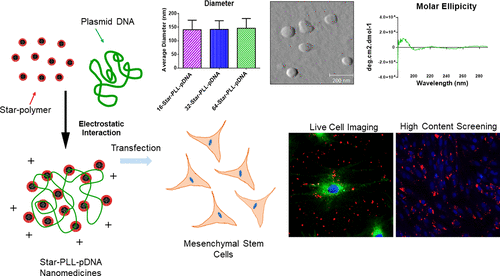当前位置:
X-MOL 学术
›
Mol. Pharmaceutics
›
论文详情
Our official English website, www.x-mol.net, welcomes your
feedback! (Note: you will need to create a separate account there.)
Bioinspired Star-Shaped Poly(l-lysine) Polypeptides: Efficient Polymeric Nanocarriers for the Delivery of DNA to Mesenchymal Stem Cells
Molecular Pharmaceutics ( IF 4.5 ) Pub Date : 2018-03-28 00:00:00 , DOI: 10.1021/acs.molpharmaceut.8b00044 David P. Walsh 1, 2, 3 , Robert D. Murphy 4 , Angela Panarella 5 , Rosanne M. Raftery 2, 3 , Brenton Cavanagh 6 , Jeremy C. Simpson 5 , Fergal J. O’Brien 2, 3 , Andreas Heise 4 , Sally-Ann Cryan 1, 2, 3
Molecular Pharmaceutics ( IF 4.5 ) Pub Date : 2018-03-28 00:00:00 , DOI: 10.1021/acs.molpharmaceut.8b00044 David P. Walsh 1, 2, 3 , Robert D. Murphy 4 , Angela Panarella 5 , Rosanne M. Raftery 2, 3 , Brenton Cavanagh 6 , Jeremy C. Simpson 5 , Fergal J. O’Brien 2, 3 , Andreas Heise 4 , Sally-Ann Cryan 1, 2, 3
Affiliation

|
The field of tissue engineering is increasingly recognizing that gene therapy can be employed for modulating in vivo cellular response thereby guiding tissue regeneration. However, the field lacks a versatile and biocompatible gene delivery platform capable of efficiently delivering transgenes to mesenchymal stem cells (MSCs), a cell type often refractory to transfection. Herein, we describe the extensive and systematic exploration of three architectural variations of star-shaped poly(l-lysine) polypeptide (star-PLL) with varying number and length of poly(l-lysine) arms as potential nonviral gene delivery vectors for MSCs. We demonstrate that star-PLL vectors are capable of self-assembling with pDNA to form stable, cationic nanomedicines. Utilizing high content screening, live cell imaging, and mechanistic uptake studies we confirm the intracellular delivery of pDNA by star-PLLs to MSCs is a rapid process, which likely proceeds via a clathrin-independent mechanism. We identify a star-PLL composition with 64 poly(l-lysine) arms and five l-lysine subunits per arm as a particularly efficient vector that is capable of delivering both reporter genes and the therapeutic transgenes bone morphogenetic protein-2 and vascular endothelial growth factor to MSCs. This composition facilitated a 1000-fold increase in transgene expression in MSCs compared to its linear analogue, linear poly(l-lysine). Furthermore, it demonstrated comparable transgene expression to the widely used vector polyethylenimine using a lower pDNA dose with significantly less cytotoxicity. Overall, this study illustrates the ability of the star-PLL vectors to facilitate efficient, nontoxic nucleic acid delivery to MSCs thereby functioning as an innovative nanomedicine platform for tissue engineering applications.
中文翻译:

生物启发的星形聚(l-赖氨酸)多肽:高效的聚合物纳米载体的DNA传递到间充质干细胞。
组织工程领域越来越认识到基因疗法可用于调节体内细胞反应从而指导组织再生。但是,该领域缺乏能够将转基因有效地递送至间充质干细胞(MSC)的通用且生物相容的基因递送平台,所述间充质干细胞是通常难以转染的细胞类型。在这里,我们描述了星形聚(l-赖氨酸)多肽(star-PLL)的三种结构变化的广泛而系统的探索,其中聚(l-赖氨酸)作为MSCs的潜在非病毒基因传递载体。我们证明了星形PLL载体能够与pDNA自组装形成稳定的阳离子纳米药物。利用高含量筛选,活细胞成像和机制摄取研究,我们确认了星形PLL将pDNA胞内递送至MSCs是一个快速过程,可能通过网格蛋白独立机制进行。我们确定了具有64个poly(l-赖氨酸)臂和5个l-赖氨酸亚基/臂,是一种特别有效的载体,能够将报告基因和治疗性转基因骨形态发生蛋白2和血管内皮生长因子同时传递给MSC。与其线性类似物,线性聚(1-赖氨酸)相比,该组合物促进了MSC中转基因表达的1000倍增加。此外,它以较低的pDNA剂量证明了与广泛使用的载体聚乙烯亚胺相当的转基因表达,且细胞毒性明显降低。总的来说,这项研究说明了星形PLL载体促进将无毒核酸有效地传递至MSC的能力,从而可作为用于组织工程应用的创新纳米医学平台。
更新日期:2018-03-28
中文翻译:

生物启发的星形聚(l-赖氨酸)多肽:高效的聚合物纳米载体的DNA传递到间充质干细胞。
组织工程领域越来越认识到基因疗法可用于调节体内细胞反应从而指导组织再生。但是,该领域缺乏能够将转基因有效地递送至间充质干细胞(MSC)的通用且生物相容的基因递送平台,所述间充质干细胞是通常难以转染的细胞类型。在这里,我们描述了星形聚(l-赖氨酸)多肽(star-PLL)的三种结构变化的广泛而系统的探索,其中聚(l-赖氨酸)作为MSCs的潜在非病毒基因传递载体。我们证明了星形PLL载体能够与pDNA自组装形成稳定的阳离子纳米药物。利用高含量筛选,活细胞成像和机制摄取研究,我们确认了星形PLL将pDNA胞内递送至MSCs是一个快速过程,可能通过网格蛋白独立机制进行。我们确定了具有64个poly(l-赖氨酸)臂和5个l-赖氨酸亚基/臂,是一种特别有效的载体,能够将报告基因和治疗性转基因骨形态发生蛋白2和血管内皮生长因子同时传递给MSC。与其线性类似物,线性聚(1-赖氨酸)相比,该组合物促进了MSC中转基因表达的1000倍增加。此外,它以较低的pDNA剂量证明了与广泛使用的载体聚乙烯亚胺相当的转基因表达,且细胞毒性明显降低。总的来说,这项研究说明了星形PLL载体促进将无毒核酸有效地传递至MSC的能力,从而可作为用于组织工程应用的创新纳米医学平台。











































 京公网安备 11010802027423号
京公网安备 11010802027423号